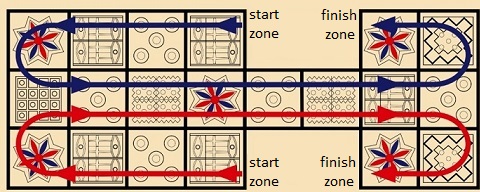The game is similar to the game called “Ludo,” and it is played only by two players, each has seven game pieces.
Rules:
• Each player enters his/her pieces from a different side of the board, and the pieces are moved 0 to 4 squares randomly, based on the number of
coloured corners showing after a roll of 4 tetrahedral dice (pyramids). Two of four corners are coloured on every pyramid.
• The first player who gets all his/her seven pieces along the correct path and moves them to the finish zone, wins the game.
• A new piece can enter the board at any time.
• A player can have more than one piece on the board and can jump over other pieces
but cannot have two pieces on the same square.
• Pieces are “safe” on the outside squares on each player’s side of the board and the
centre rosette square.
• A piece in the centre line of squares, except for the rosette square (square 8), is kicked off the board and must start again if an opponent’s piece
lands on the same non-rosette square the piece is occupying.
• Landing on a rosette square (squares 4, 8, and 13) gives a player another roll of the pyramid dice.
• To move a piece off the board, one must throw an exact match; e.g., if there are two
squares left, one must throw a 3 to land off the board.
• A move must be taken. Only if no move is possible, the turn is lost.
• The game is played in the direction indicated in the picture with pieces off the board (placed in the start zone).

We should mention that archaeologists have not determined the exact rules and the exact path on the board yet. Therefore, you may also encounter different rules with various slight deviations elaborated by other authors. We use the board path and the rules suggested by Irving Finkel, a curator of the British Museum, who deciphered the rules.